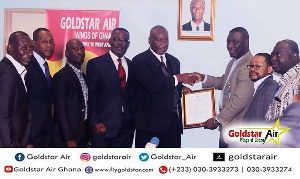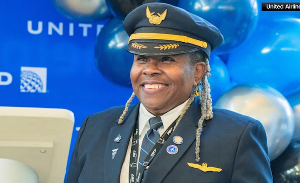- Home - News
- TWI News | TV
- Polls
- Year In Review
- News Archive
- Crime & Punishment
- Politics
- Regional
- Editorial
- Health
- Ghanaians Abroad
- Tabloid
- Africa
- Religion
- Election 2020
- Coronavirus
- News Videos | TV
- Photo Archives
- News Headlines
- Press Release
Press Releases of Monday, 13 May 2024
Source: Goldstar Air
Tamale Aviation Training Organization to commence soon
Goldstar Air, the Wings of Ghana, will commence the Tamale Aviation Training Organization of our City Project (Phase 5) soon. The Approved Training will equip current and future generations of aviation professionals with the skills and tools to overcome industry challenges.
Tamale is the capital of Ghana’s Northern Region with a population of around 400,000 and it is Ghana’s third largest city by population after Accra and Kumasi. The city is served by Tamale International Airport, located some 15km north of the center.
According to the Chairman and Chief Executive Officer of Goldstar Air, Eric Bannerman, the airline will acquire certification for the school from the United States Federal Aviation Administration (FAA), European Union Aviation Safety Agency (EASA), Ghana Civil Aviation Authority (GCAA), International Air Transport Association (IATA), Operational Safety Audit (IOSA), and Authorized Training Center.
The training school will upskill people to stay sharp, fine-tune, and always be prepared. This will empower them with the unwavering calmness and composure needed for all situations, from the every day to the unusual. Our training will be more than fulfilling a requirement. It will be an achievement reserved for the sky’s most elite.
Mr. Bannerman emphasized that the training school will meet all the needs of aviation- related courses, whether initial, recurrent, advanced, or special operations training.
We will operate with an emphasis on reliability, convenience, and flexibility. Our goal is to advance missions by offering the specific training support needed, including access to cutting-edge simulator technology, specially designed training environments, and the expertise of professional European Union Aviation Safety Agency (EASA), and United States Federal Aviation Administration (FAA) qualified instructors.
We will offer initial and updated aviation training for professional technicians, developed closely with Boeing Company and the Michigan Aerospace Manufacturers Association (MAMA). We will begin with in-depth classroom instruction, then our interactive applied training reinforces the lessons learned. This approach crafts the ideal balance in instruction between academic knowledge and practical experience.
The aviation training school will create a multicultural learning environment, with students from all over the world. This intercultural learning competency will help students feel comfortable working in different countries throughout their careers or sharing the cockpit of an airline with a pilot from another culture.
Goldstar Air training school's unique techniques and resources and 24-hour service will provide and help build aviation professionals' capability and capacity, ensuring they can thrive in a rapidly changing industry. The airline will give scholarships to the less privileged in Northern Ghana through On-the-job training so they can be part of future aviation professionals.
Aerospace engineering licenses are dependent on completing relevant qualifications and gaining practical experience. A good fitness level is required as the role will include heavy lifting, lots of walking, and climbing ladders. Our training will go beyond the basics.
It will be the difference between ‘good enough’ and ‘best of the best.’ Training the best leads to a more efficient maintenance department so aircraft are maintained correctly the first time, faster, and as frequently as required.
The aviation industry has seen growth over time and currently, it is estimated that the United States has around 617,000 pilots who hold active pilot certificates. In addition to the impressive pilot production numbers, there are 86,774 certified flight instructors. Nigeria boasts 2,133 licensed pilots, 1,659 aircraft maintenance engineers, 371 air traffic controllers, and 2,343 cabin crew licenses.
This demonstrates further that the commercial airline pilot pipeline remains robust and a signal for Ghana to emulate by taking advantage of the training school to train more Ghanaians.
Goldstar Air will offer a full range of high-quality FAA and EASA-approved aviation training course-ware and reference products that will be trusted around the globe for decades.
The school will take an application-oriented approach to training, which incorporates real- world scenarios and examples, so people will discover the why and how of aeronautical concepts and not just the facts needed to pass a test.
From the initial pilot and technical certification to advanced ratings and Airline Transport Pilot (ATP), Goldstar Air has you covered with the training solutions to support your passion.
The FAA Airframe and Powerplant (A&P) license is a more general certification covering both Airframe and Powerplant work and is recognized mainly in the USA. One may obtain the training and experience necessary to become an FAA-certificated Airframe and or Powerplant Mechanic via two means.
The first is Academy training through an FAA-certificated Aviation Maintenance Technician School (AMTS) and the second is On-the-job training (OJT) that provides practical experience with the procedures, practices, materials, tools, machine tools, and equipment generally used in constructing, maintaining, or altering airframes or powerplants, appropriate to the rating sought.
Once you meet the On-the-job experience requirements, there are commercially available Airframe and Powerplant refresher courses and Airframe and Powerplant prep courses that will help prepare you to pass the airman knowledge written, oral, and practical tests.
Usually, On-the-job training is the most inexpensive method for gaining the required experience. You will need to document consistently your OJT activities. FAA recommends you record your experience on an Aviation Maintenance Technician (AMT) log. In your log, ensure that you include the Maintenance task performed, Time spent on each task, and Validation by a certificated Airframe and or Powerplant Technician. Under Part 66, the common European legal framework for certifying licensed aircraft engineers, there are three main categories of aerospace engineering licenses in the European Aviation Safety Agency member states A, B, and C.
The EASA Category A License is a ramp or line maintenance certifying mechanic who typically performs relatively minor maintenance tasks and simple part replacements that may be required and certifies these tasks.
Category A Aircraft Maintenance Engineers License (AMEL) allows the holder to issue Certificates of Release to service (When supported by an Approved Maintenance Organization - AMO (145)) following minor ‘Task Trained’ scheduled line maintenance and simple defect rectification within the limits of the tasks specifically endorsed on the company authorization but requires assistance like wheel change in a Part-145 organization.
The EASA Category B1 License is mechanical (aircraft structure, powerplant, and mechanical and electrical systems) divided into four sub-categories. The B2 specializes in avionics (communications, navigation, radar, instrument, and electrical systems) and is recognized in all EASA member states. Holders of EASA Category B License may provide a Certificate of Release of Service of aircraft following maintenance and repair tasks.
To become a B1 or B2 licensed aircraft engineer, one must obtain a relevant educational background in aircraft maintenance engineering or related fields. B2 licensed engineers can work varied hours, including nights, weekends, bank holidays, and Christmas.
Hours can be long, and most engineers will be required to work overseas which could result in prolonged periods away from home.
Category B2 licensed engineers can continue their professional development and work towards their Category C license which is obtained by completing the relevant qualifications and gaining the required experience. This allows an engineer to issue a Certificate of Release of Service and aircraft overhauls.
The pilot’s certificate is one of several airman certificates issued by the FAA for flight engineers, flight instructors, ground instructors, aircraft dispatchers, mechanics/repairmen, parachute riggers, control tower operators, flight navigators, and flight attendants. Pilots training represents a comprehensive and all-encompassing program that incorporates theoretical instruction and practical flight training, complemented by simulator-based exercises. The escalating shortage of pilots is projected to catalyze the expansion of the global market.
FAA-approved pilot schools are certificated by Title 14, Code of Federal Regulations Part 141. Enrollment in an FAA-approved pilot school usually ensures a high quality of training. The first step to becoming a pilot is to decide what you want to fly.
FAA’s rules for getting a pilot’s license (certificate) differ depending on the type of aircraft you fly. You can choose among airplanes, gyroplanes, helicopters, gliders, balloons, or airships. To fly ultralight vehicles, you do not need a pilot’s license. You should also think about what type of flying you want to do. There are several kinds of pilot’s licenses, from student pilots to airline transport pilots.
EASA Zero to Air Transport Pilot License-ATPL(A) course is designed for students with little or no flying experience and who want to pursue a career in aviation according to EASA regulations.
During the Zero to ATPL Ground Training course, the trainee will complete theoretical courses for Private Pilot License-PPL(A), Instrument Rating-IR(A), Commercial Pilot License-CPL(A), and MEL(A) and must be at least 18 years of age, capable of holding FAA and EASA pilot medical certificate class 1.
The Integrated Air Transport Pilot License-ATPL(A) Flight Training course will be divided into 6 phases training, developing basic flight skills, Initiation to complex flying, Introduction to Commercial Flying, Advanced flight skills, advanced upset prevention and recovery training (UPRT), and multi-crew cooperation course (MCC).
The IATA Operational Safety Audit (IOSA) Program is an internationally recognized and accepted evaluation system designed to assess the airline's operational management and control systems.
The IOSA audit creates a standard that is comparable on a worldwide basis, enabling and maximizing the joint use of audit reports. This has saved the industry over 6,400 redundant audits and continues to lead to extensive cost-savings for IOSA- participating airlines. All IATA members are IOSA registered and must remain registered to maintain IATA membership.
In 2023, the International Air Transport Association evolved its partnership model to a tiered approach for Authorized Training Centers (ATCs) with 2 entry levels, ATC Affiliate and ATC Classic.
ATC Affiliate Authorization is provided to organizations who wish to resell IATA self-study and e-learning courses. ATC Classic Authorization is granted based on demonstrated instructional expertise and the institution’s overall ability to provide quality training.
ATC Classic can progress to ATC Preferred and the highest tier, ATC Premier. Authorized Training Centres recruit and train students, while IATA conducts examinations through OERS (Online Examinations with Remote Supervision). Successful candidates are awarded an IATA certificate.
According to the International Civil Aviation Authority (ICAO), a sustainable, safe, and secure global aviation development relies on the availability of qualified and competent employees, supervisors and managers to plan, coordinate, manage, operate, maintain, and oversee all complex operations in various airports, airspaces, airplanes, etc.
The aviation training organization is envisaged to create more jobs for the people of Tamale and its environs and will open business opportunities for the Northern sector of the country.
Goldstar Air will be creating over one hundred thousand direct jobs in Ghana. Some of the jobs that the youth will benefit from include Pilots, Ground Service Crew, Service Person In Maintenance, Accountants, Flight Dispatchers, Drivers, Marketing Personnel, Cleaners, IT Managers, Cargo Agents, Catering Services, Fuel Suppliers, and others, as well as, exporting labour through an agency on call, charter, and aircraft leasing.
Afrik Allianz members will have a discounted price anytime they bring their staff to the school for any aviation training-related course so we can respond proactively to the market changes, rather than reactively.
New opportunities for A1 have cropped up in all facets of our business and raising customer expectations, so we are confident that the facts and our expertise will thrive and occupy a bigger market share, the pressure to digitize becomes even more apparent.
Goldstar Air will initially operate flights from Kumasi Prempeh 1 International Airport to Rome, Madrid, Hamburg, London, Dusseldorf, and Milan. Also, flights from Accra Kotoka International Airport shall include destinations such as Washington, Dubai, Lagos, Toronto, Monrovia, Conakry, Abidjan, Guangzhou, Dakar, Banjul, Rhode Island, London, and Freetown.
The Aviation Training Facility (Phase 5) will be named after a prominent Chief in Northern Ghana, initial contact has been made and the management team will go and pay him a courtesy call to officially notify him and in addition, present a Citation to him. In conclusion, after this, the Tamale Aviation Training Organization publication will be closely followed by another article regarding the Tamale Aviation Catering Services (Phase 6) of the Tamale City Project which will be on the same premises as the Training Organization











